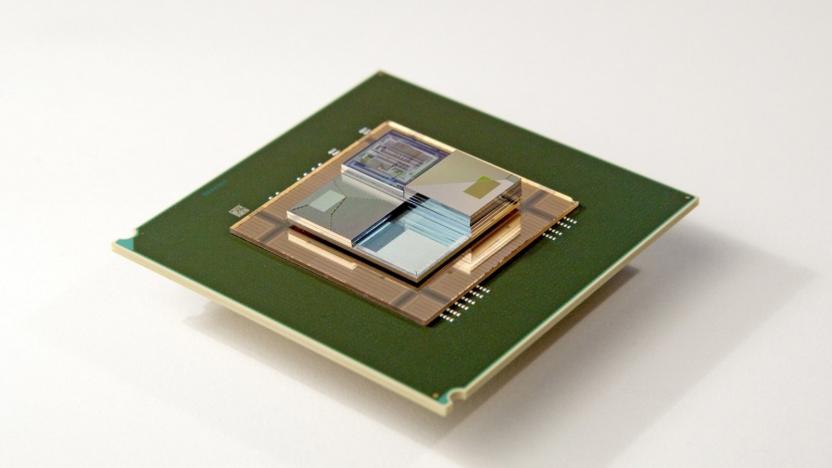electrolyte
Latest

Water-based electrolytes promise safer phone batteries
It's hard to completely escape safety issues with lithium-ion batteries, in part due to the nature of the electrolytes that charge and release energy when ions shuttle between electrodes. They usually have to be made of easily combustible chemicals to muster enough power. However, that might not be a problem for much longer. Scientists have crafted a water-based electrolyte that's both considerably safer and manages enough voltage (4V) to be useful.

Tiny liquid battery cools chips while powering them
Scientists from IBM and ETH Zurich university have built a tiny "flow" battery that has the dual benefit of supplying power to chips and cooling them at the same time. Even taking pumping into account, it produces enough energy to power a chip while dissipating much more heat than it generates. The result could be smaller, more efficient chips, solar cells that store their own energy or devices used for remote monitoring that don't require external power sources.

Artist runs an electronic sound exhibit using his own blood
Russian artist Vtol is no stranger to making sounds with unusual technology, but one of his latest projects might top them all. He recently created Until I Die, an electronic sound installation powered by himself -- namely, his blood. His creation uses vital fluid as an electrolyte that, when combined with metals like aluminum and copper, results in direct current batteries. The project isn't about to compete with the battery in your phone (five batteries manage a capacity of just 1,000mAh), but that's enough to power a synth module and speaker for roughly 8 hours.

Green House's lantern runs on salt and water, powers your gadgets via USB
Japanese company Green House Co Ltd has quite an eclectic product portfolio, what with its women-only camcorder and peripherals like a PCI Express interface card with USB 3.0 support. Its latest device falls under another category entirely: the rivetingly named GH-LED10WBW is an LED lantern that runs on just water and salt; no batteries required. The light source provides eight hours of electricity per dose of saline water, and the lantern comes with a dedicated water bag for mixing the solution. The salt / water combo acts as an electrolyte with the magnesium (negative electrode) and carbon (positive electrode) rods inside the lantern. Users can get about 120 hours of power with the Mg rod before they'll need to buy a replacement (the rod is sold separately to begin with). More than just supplying a battery-free source of light, though, the lantern can function as a charger, thanks to a USB port built into the casing. Pricing has yet to be announced, but the GH-LED10WBW will be available by mid-September.

Hitachi claims secret chemical formula will improve battery cathodes, double longevity
Before lithium-ion batteries, portable gadgets were a nightmare, forcing road warriors and Discman-toting teens to either swap disposable cells or deal with rechargables that (with few exceptions) were tricky to recharge. Of course, Li-ion batteries also have a downside: as laptop and cell phone users have no doubt found out, they too become disposable before long. One reason why is that acid in the electrolyte can corrode the cathode material -- and now, Hitachi claims it's found a way to strengthen its own. Using an undisclosed combination of elements to replace some of the manganese used in the company's cathodes, Hitachi claims they can strengthen their crystalline configuration to resist acid, reduce cost, and best of all, double the usable life of a lithium-ion cell to about ten years. We've heard similar claims before, of course, with other battery manufacturers promising us twenty years, but it looks like this technology might make it out of the lab. NEDO, a Japanese government organization, has commissioned Hitachi to bring these batteries to life for industrial applications like wind farms. Cell phones, sadly, will have to wait.

MIT gurus concoct Li-ion batteries that build themself
It's fairly reassuring that if those rollable, water-powered, paper, and ultracapacitor-based battery ideas don't exactly pan out, we've got yet another idea coming out of MIT that just might gain traction. Apparently, scientists at the university are working on self-assembling Li-ion cells when not thinking about what witty remark they'll plaster on their own spacecraft, and it seems that Yet-Ming Chiang and his colleagues have selected electrode and electrolyte materials that, when combined, "organize themselves into the structure of a working battery." By measuring various forces with "ultraprecise atomic-force microscope probes," the researchers were able to choose materials with just the right combination of attractive and repulsive forces, essentially creating a perfect environment for batteries that could build themselves. Additionally, a current prototype has displayed the ability to be discharged and recharged "multiple times," and while commercial uses aren't nailed down just yet, the backers are already envisioning how the technology could be used in minuscule devices where standard cells won't exactly fit in. Let's just hope this stuff doesn't cause too much friction whilst building itself up, eh?[Via TheRawFeed]



